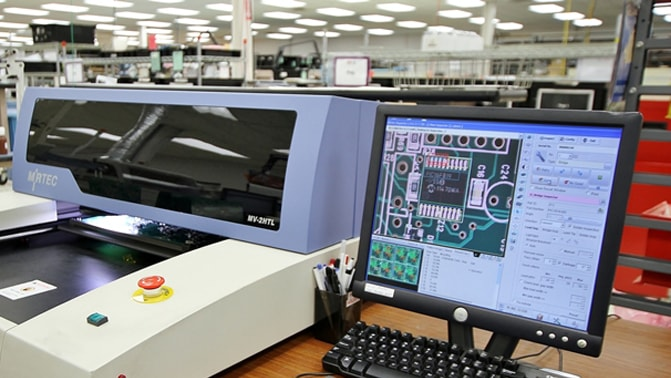Inline AOI System
Automated Optical Inspection (AOI) is a technology used in various industries, particularly in manufacturing and quality control, to inspect and analyze products using optical systems and computer algorithms. The primary goal of AOI is to detect defects, inconsistencies, or deviations from desired specifications in manufactured products. It is especially useful for tasks that require precision and speed, as well as the ability to inspect large volumes of products.
AOI systems are commonly employed in industries such as electronics manufacturing (PCB inspection), automotive manufacturing, pharmaceuticals, textiles, and more. Here’s how AOI generally works:
Capture Images: The process begins by capturing high-resolution images of the product under inspection using cameras or imaging devices. In the context of PCB inspection, for instance, these images might capture the solder joints, components, traces, and other relevant details.
Image Processing: The captured images are then subjected to various image processing techniques. These techniques help enhance the images, normalize lighting conditions, and prepare them for analysis.
Defect Detection: Computer algorithms analyze the processed images to identify defects or anomalies. These algorithms compare the images against predefined standards or specifications to determine if any deviations exist. Defects can include missing components, incorrect placements, soldering issues, misalignments, and more.
Classification and Sorting: Detected defects are often classified based on severity or type. This classification allows for the efficient sorting of products. Depending on the industry and the severity of the defects, products might be categorized as pass, fail, or require further human inspection.
Reporting and Analysis: AOI systems generate detailed reports on the inspection results. These reports can include images of the defects, their locations, and additional information that helps in diagnosing the cause of the defects. This information is valuable for process improvement and corrective actions.
Purpose of AOI
Speed and Efficiency: AOI systems can inspect products at high speeds, often much faster than manual inspection.
Consistency: AOI eliminates human subjectivity, ensuring that the inspection process is consistent and unbiased.
Reduced Costs: Detecting defects early in the manufacturing process helps minimize rework and scrap, reducing overall production costs.
Data Collection: AOI systems can collect extensive data on defects, which can be used for process optimization and quality improvement.
An Inline Automated Optical Inspection (AOI) system refers to the integration of AOI technology directly into the production line of a manufacturing process. In this setup, products are inspected as they move along the production line, allowing for real-time defect detection and immediate corrective actions if necessary. Inline AOI systems are commonly used in industries where high-volume production is essential, and quality control is a critical factor.
Here’s how an inline AOI system works
Integration into Production Line: The AOI system is positioned at a specific point along the production line where the product is in a suitable position for inspection. This could be after soldering components onto a PCB, assembling parts, or any other step where defects are likely to occur.
Automated Inspection: As the products move along the conveyor or assembly line, they are captured by cameras or imaging devices integrated into the AOI system. These devices capture high-resolution images of the product.
Real-time Analysis: The captured images are processed by computer algorithms in real-time. These algorithms compare the images against predetermined standards or specifications to identify defects or anomalies.
Defect Detection and Classification: Detected defects are categorized based on severity or type. Depending on the nature of the defect, the system might trigger actions such as sending a signal to remove the faulty product from the production line, stopping the line for manual inspection, or initiating automated rework processes.
Data and Reporting: Inline AOI systems provide real-time data on the inspection results. This data can include defect statistics, images of the defects, and other relevant information. Manufacturers can use this data to monitor the production process, identify trends, and make necessary adjustments to improve quality.
Immediate Corrective Actions: One of the key advantages of an inline AOI system is the ability to take immediate corrective actions. If a defect is detected, the system can stop the production line or divert the faulty product for further analysis or rework. This prevents defective products from progressing further in the production process, minimizing waste and rework costs.
Inline AOI systems offer several benefits
Real-time Detection: Defects are caught immediately, reducing the chances of producing a large batch of defective products before noticing an issue.
Reduced Downtime: Inline AOI can help prevent the production of defective products, which could lead to costly downtime for rework or recalls.
Efficiency: Continuous monitoring and immediate corrective actions lead to efficient production and higher overall quality.
Data-Driven Decision Making: Real-time data collection and analysis help manufacturers make informed decisions about process improvements.
Implementing an inline AOI system requires careful planning and integration into the existing production line. It’s also important to consider the balance between the speed of inspection and the accuracy of defect detection to ensure that the system can keep up with the production rate while maintaining reliable results.
Source

